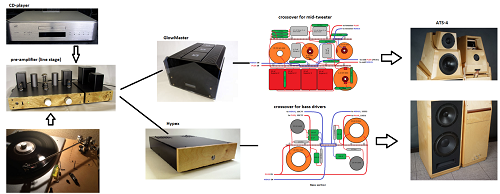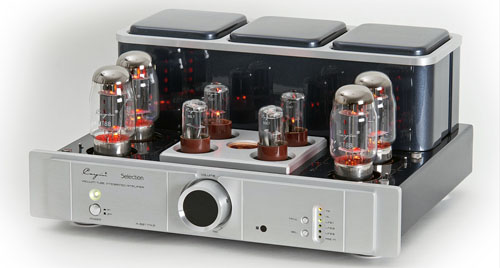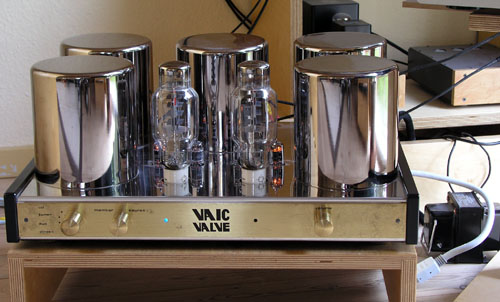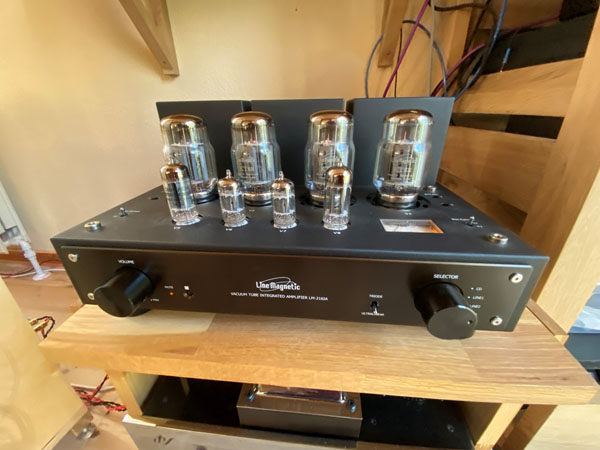DIY Loudspeakers: HOME INDEX UPDATES RESPONSE WHAT'S NEW
Amps for TQWT and DTQWT speakers
|
Over the
last four decades I've had an endless list of
amplifiers, mostly diy stuff based on designs published
in magazines and mostly class AB solid state. Linsley
Hood's 10 watt class A amp and Nelson Pass' 20 watt class
A amps may ring a bell for those old enough. Next some
Erno Borbely mos-fet amps were built before "The
End" appeared in Danish "High Fidelity"
magazine. This amp was developed into the LC Audio range
of products and I built most of them. After that I
started buying amplifiers and Luxman MQ70 (EL34 valves)
was my main amplifier for several years until someone brought
in some 20 watt PSE 300B mono blocks and my road to aural
nirvana took quite a turn as can be seen from my
gear
pages. Later I've
acquired some solid state amps again, the
Jungson JA88D-09,
low-feedback, partly class A amps to run my
Jenzen speakers. Even
my 40
watts
SET
6C33 triodes couldn't cope with 88-89 dB sensitivity speakers. With regard to the DTQWT speaker,
I wish I had a wider selection of amps to refer to but
I've only had the opportunity to hear these speakers with
a good handful of amps like my 8 watts
300B, 20 wpc
Audio
Mirror mono blocks, Gain Clone (used for CLIO
measurements), Rotel RB981 solid state driven by my
WOT line stage, 8
wpc 2A3 push-pull design (discontinued) from DiyHifiSupply, Hong Kong, 15
wpc
T16-OTL from
Transcendent, 15 wpc 300B design from
TriodeDick/Holland (built by DTQWT
customer), 25 wpc amp from Jasmin (Sonata, EL156 valves), Nelson Pass
FirstWatt JP2
and most recently my JungSon
JA88D. Generally I prefer the valve amps over the solid state with the JungSon as an exception. What I would like to try are a few British amps like Croft, Exposure, Naim, Sugden (e.g. A21). My default amp(s) for DTQWT is the EAR-861 for mid-tweeter and maybe Hypex for bass, i.e. bi-amping. With Hypex' introduction of the FUSION plate amps I would use the FA251 these days for running the bass driver(s). The FA251 has the advantage of being able to take the signal from the speaker cables (high level input) and makes an easy set-up. Furthermore you may omit the low-pass filter for the bass driver and use the DSP of the Hypex. I haven't tried this an cannot give any solid advice on points of crossover and slopes, but try 100 Hz, 1st order and hear what happens.
Due
to room placement I have minimum room-gain and I rush to
say that my DTQWTs in a smaller room and placed closer to
the corners may sound better in the bass region from
other amps with a more tight bass performance. The TQWT and DTQWT speakers
were designed to offer a speaker alternative to all those
investing in low-wattage SET amps, but somewhat to my
surprise most customers to these kits use solid state
gear. The majority of solid state amps are 50-100 wpc
push-pull class B amps and with all respect they may
offer a decent compromise with regard to price and
performance. To some DTQWT customers there may be more to
extract from your source material by trying a variety of
low-wattage valve/solid state amps where quality has
priority over quantity. It's easy - and cheap - these
days to make a 100-200 wpc solid state amp, but the
general concept of push-pull class AB designs with global feedback has its
shortcomings when it comes to sound quality. To my ears! I rush to say I
haven't heard them all so I'm sure there are exceptions. As mentioned by Swedish builder
Ilpo, the DTQWT can also play
seriously loud with low distortion, thus an
option for potent surround systems, something I hadn't
anticipated when I made the speakers. Here some decent
solid state gear may beat all the SET amps by a
comfortable margin. Despite high efficiency we need quite
a few watts to cope with 100-105 dB peak program
material. Pure math comes short here. It doesn't help
calculating the watts needed to make 105 dB, we need
serious headroom to cope with this kind of application.
My default recommendation for an amp for the TQWT/DTQWT is a PP
valve design like the Cayin A50T, A55T, A88T, etc. These amps usually delivering 20-25 wpc
in triode mode and 35-45 watts in pentode mode. Last, but not least: I have twice seen 8008 main driver's cone ripped apart from using e.g. 400 watt solid state amp - or lending the system to children's Saturday Night disco party. This from DTQWT mkII and DTQWT-12. Now, the DTQWT-12 was not made to play louder, only deeper. The main front driver still carries the full low-end signal and 95 dB sensitive speakers should simply not be fed 400 solid state watts. The voice coil was fully intact but the cone was just simply ripped apart. The other reason for this was that the speakers were supposed to energise more than 100 square metres rooms. This is equivalent to a smaller cinema space - and this is a completely different story. Before building speakers we need to analyse what kind of sound level we're aiming at, what is the room size - and volume, and what kind of amplifier are we going to use.
|
| FAQ on bi-amping: |
I've had the question on bi-amping the DTQWT and there are a number of considerations to address as listed below. Next I have the question on bi-amping plus use of an electronic crossover to substitute the bass drivers' low-pass filter. First of all I hardly see the rationale for bi-amping a 95 dB system where there's no high-pass filter to the front drivers and only a simple 1st order filter - with an extremely low DCR series coil - to the bass drivers. The system as such requires little power compared to a modern low-efficiency speaker, but should you want to run a 2-4 watt SET on the front drivers, it may certainly benefit from not having to run the bass drivers as well, but this is not without problems. We need to reiterate the situation as described in the DTQWT file: http://www.troelsgravesen.dk/JA8008_DTQWT.htm
"The DTQWT construction has an
8" front driver and two 10" rear mounted
drivers, all connected with positive polarity. They're
placed opposite to one another and the rear drivers are
fed through a huge coil, thus only adding weight to the
lower octaves. All drivers load a center horn and you may
ask whether the large bass drivers won't have an impact
on the front driver from sharing the same open space and
the answer is yes - and this is intentional. Air goes
where pressure is low, thus when the
rear bass drivers move inwards, they will push air into
the large center horn and by doing so they will suck air
from the front horn and pull the membrane of the front
driver. Obviously the front driver will do the same thing
for the bass drivers. We have a
situation similar to a push-push configuration of two
opposite placed bass drivers in a vented cabinet. Based on experience, the amps running the front and rear drivers have to be the same. Using my Audio Mirror amps for the front drivers plus an e.g. Rotel power amp for the bass drivers didn't perform too well playing at loud levels. I guess that the amps have different phase characteristics in the bass region, thus jeopordize the synergy between front and rear drivers loading the same center horn. Amps being either AC or DC coupled may have an impact on this. Bi-amping and electronic crossover
to the bass: The bass crossover is a low slope
1st order filter and has a significant impact on upper
bass/lower mid. Cutting the bass by e.g. 12-24 dB at e.g.
100 Hz will render upper bass/lower mid weakened. My current solution for bi-amping is this, which I use this for all larger speakers that simply can't be run from even 40 watt PP tube amps unless you never play very loud. http://www.troelsgravesen.dk/Diy_Loudspeaker_Projects_files/bi-amping.png. All in all not that easy - and again: I hardly see the rationale given the system's sensitivity. |




